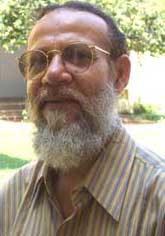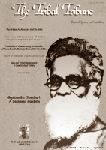Nature Talk
Obituary

Professor Subrata K. Chakrabarti
(1947-2016)
An eminent prehistorian of India Professor Subrata K. Chakrabarti breathed his last on 14th March, 2016 at a private hospital in Kolkata. He was ailing for the last few months.
Born on 21st May, 1947 he passed B.A. in History from University of Calcutta in 1968. He did his M.A. in Archaeology also from the same University in 1970 (1972). Then in he moved to Deccan College Post-Graduate & Research Institute, Pune to undertake his doctoral research under the academic supervision of the celebrated archaeologist Prof. H. D. Sankalia. His Ph. D. was on Prehistory of Bhavnagar District, Saurashtra, Gujrat which he completed during 1977-78. As far as I know Professor Desmond Clark - who was one of the examiners – appreciated his thesis. Then he was pursuing his Post-Doctoral research on Acheulian Culture of Saurashtra, Western India during the period 1977-1979. After that he joined as a faculty member in the Department of Ancient Indian History, Culture & Archaeology, Visva- Bharati, Santiniketan, West Bengal. Subsequently he became Reader, Professor and Head of the Department in the same University.
Apart from Saurashtra, Professor Chakrabarti had worked on the prehistory of Bengal and Odisha. He had undertaken trial excavation at Malati Sadar Ghat Acheulian site in Birbhum and exploration at Basudih, Purulia. He had also worked on the Mesolithic culture in northeast Bankura. In his Dharani Sen Memorial Lecture in 2001 he had reviewed the state of Bengal Prehistory.
In Odisha he had basically worked on the prehistory of Mayurbhanj and had published a paper in Archaeology of Orissa (2000) edited by Pradeep Mohanty and myself. On the basis of his survey around Kuliana and its adjacent areas, Prof. Chakrabarti during 1990s pointed out that the area had a series of Tertiary marine fossiliferous limestones designated as the Baripada beds, underlying the Quaternary formations. The occurrence of boulder beds of the former channel, completely hidden under alluvium and laterite incorporating Lower Palaeolithic artefacts assumes archaeological significance. The Baripada Beds have been placed in the lower Pleistocene. Since the extension of the Kuliana sequence of Palaeolithic implements has been well established into the nearby Burhabalanga boulder conglomerate bed, the lower limit of the Lower Palaeolithic of the area, Chakrabati felt, could be the lower Pleistocene. This is significant in the light of recent dating of Attiramakkam in South India to lower Pleistocene.
Professor Chakrabarti was awarded the Dharani Sen Memorial Plaque for his contribution to prehistory by the Indian Anthropological Society. Besides, he was Member, Editorial Board of the e-journal The Tribal Tribune. He wrote an extremely interesting article in this journal (vol.5, Issue 4), under an offbeat title ‘Neolithic Money: A Matter Off Market’, where he could make “a few hazardous guesses on the idea of ‘money’ in the context of the Neolithic” and with such money economy could interpret Neolithic “as a time of ‘escape from the impasse of savagery’ to bring out ‘an economic and scientific revolution that made the participants active partners with nature instead of parasites on nature’”.
Professor Chakrabarti was a Member of the Standing Committee of the Central Advisory Board in Archaeology of the Govt. of India as well as a Member of the Indira Gandhi Rashtriya Manav Sangrahalaya Samiti, Bhopal under Ministry of Culture, Govt of India. He had delivered lectures in a number of seminars as an invited speaker. A soft-spoken man, he was well read and his reading was much beyond his disciplinary boundary. He was also in charge of Publication in Visva-Bharati. Earlier in 1988, he along with N C Ghosh had edited a proceedings of the archeological conference held under the auspices of the Department of Ancient Indian History Culture and Archaeology at Visva Bharati, which was published in 1990 by the Research Publications division of Visva Bharati under the title ‘Adaptation and other essays: proceedings of the Archaeological Conference, 1988 ’ . This volume has been since considered an useful body of knowledge in understanding deeper recesses of archeology.
I had the privilege of knowing Professor Chakrabarti since 1980 when I had visited Deccan College, Pune. But we became close friend from 1990s. A well dressed and articulate academic, he has two weaknesses – his guru Professor H. D. Sankalia and the founder of Visva-Bharati Rabindra Nath Tagore. Once he starts talking about any one of them, there is no end to it. But to my utter surprise, he used to bring out different aspects of these great men on each occasion he used to talk.
While Professor Subrat Chakrabarti’s demise is an irreparable loss to the Indian fraternity of prehistorians, it is a great personal loss to me. Both my wife Tilottama and myself visited him on 7th March, 2016 at his Santiniketan residence. He was frail to the bone and was speaking in a feeble voice. But the hospitality in him had got the better of his serious ailment. We came back on 7th March evening realizing that he might survive at best for a few more months. He was to be shifted to Kolkata on the next day. But I never in my wildest dream thought that he would pass away in the next week.
May his soul rest in peace. (K K Basa)



